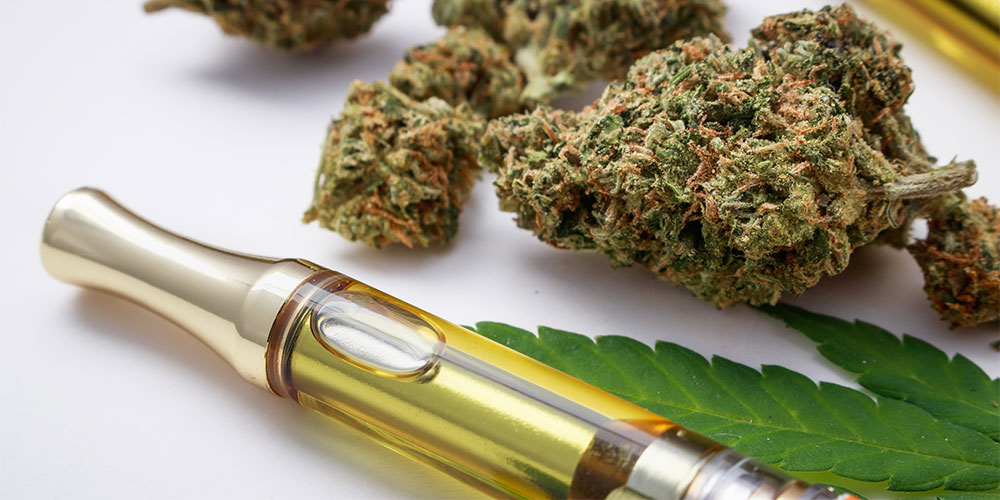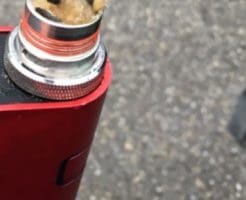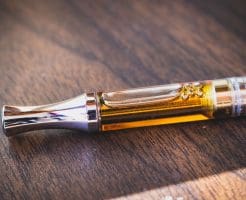Vape Pens: How Students Are Using Them to Abuse Drugs
Concerns over the use of vape pens to inhale drugs continue to grow as hundreds of vaping-related illnesses have been reported.

As vape pens continue to sweep the country, we are quickly finding out (and many people still don’t know) what is actually inside these devices.
There are vapes that work for nicotine, flavored oils without nicotine, marijuana and even synthetics. People might be inhaling marijuana using a vape pen right in front of you and you have no idea. Therein lies the rub.
Now, we are not saying that everyone is smoking drugs out of vape pens. However, a lot of law enforcement officers on the street are finding many people are using these devices for drugs.
The substances we seem to be finding the most in vape pens during traffic stops, in schools, in hospitals and in other public places include:
- Dry herbal marijuana
- Marijuana wax (see Slide 1)
- Marijuana oil (see Slide 2)
We are also seeing an increase in oil forms of synthetic drugs through vape pens.
What’s Inside That Vape Pen?
In the 2015 January/February issue of Campus Safety magazine, I wrote an article on the use of marijuana concentrates and their popularity. Marijuana concentrates and vape pens are the perfect marriage: concentrates come in oil, wax or crystal form, and the current versions of vape pens can work for all three.
A recent survey released by Monitoring the Future, which is funded by the National Institute on Drug Abuse (NIDA), found a 10% increase in teen vaping from 2016 to 2017 – equating to 1.3 million more teens vaping within a single year.

Figure 1: In 2018, nearly 2 in 5 students in 12th grade reported past-year vaping. (Image credit: Monitoring the Future survey)
While the majority of teens are vaping nicotine, the NIDA study found a concerning percentage are using pens to vape marijuana or hash oil, including 12.4% of eighth-graders, 10.8% of tenth-graders and 13.1% of twelfth-graders (see Figure 1 for further breakdown). Additional findings from the survey regarding vaping, marijuana and other drugs can be viewed in the slideshow.
Here is where the hurdles occur: you can’t simply look at someone smoking from a vape pen and know what is inside the pen that they are inhaling from. So, how can you tell if someone is vaping?
First, we need to understand these pens a little better. The baseline when dealing with vape pens is there are no absolutes.
When law enforcement officers and the public were first introduced to vape pens, many of us learned an electric device vaporizes a liquid form of nicotine. Many forms of nicotine are found in vape shops, convenience stores, gas stations, grocery outlets and even alcohol outlets, depending on the state.
Many of the pens you see that are being used for nicotine look similar to some of the pens in the drug world and vice/versa.
No One Suspects You’re Inhaling a Drug
Over the last few years, vape pens for drug use have become popular. They can be colorful, compact and very discrete, with the latter being a large selling point to these various pens.
The most popularly used pen today is the Juul – a small, sleek device that resembles a flash drive. A recent survey of nearly 200,000 young people found Juul is the preferred brand for 60% of high school e-cigarette users.
Imagine: sitting at a stoplight next to a police car, in a dance club or even in a movie theater taking a hit of a drug and no one around you suspects drug use. Or, sitting in a classroom and the professor turns their back for a few seconds as they write on the dry erase board; meanwhile, the person next to you is “vaping,” but in actuality, they are taking a hit of something. What is that something you ask? If it is a drug, there is a good chance it’s marijuana.
How can this be done and others might not detect it? As mentioned in my previous marijuana wax article, marijuana concentrates can be hard to detect, carry very little odor and are not a green, leafy substance. Once you place these various forms of marijuana into a quality vape pen, that pen can produce little to no odor, thereby reducing or eliminating the known odor of marijuana.
Furthermore, the user is receiving a stronger high. Also, any odor that is present and the lingering smell of marijuana are reduced, again making it hard to detect.
How to Determine What Type of Vape Pen Is Being Used
First, you should open it. Inside the pen, you might see a raised wick surrounded by a coil, a flat coil or just a cylinder. The packed or used residue of the product will be inside these areas.
Wax inside of a vape pen will generally test with law enforcement kits. Also, if the pen has been smoked recently, there sometimes will be the odor of smoked marijuana coming from inside the pen.
It should be noted that a closed pen with wax on the inside will produce very little to no smell. Also, if you choose to open it, I would recommend wearing gloves as you don’t know the extraction method or what else it might contain.
Thousands of Vaping-Related Illnesses Linked to Marijuana Products
Significant concerns continue to swirl in recent months as authorities attempt to understand a rash of mysterious vaping-linked illnesses. The latest federal data shows there are more than 2,000 of these cases across every state but Alaska, according to The Washington Post.
Many victims have been diagnosed with acute respiratory distress syndrome, a life-threatening condition in which fluid builds up in the lungs and prevents oxygen from circulating in the bloodstream. At least 39 deaths in 24 states and the District of Columbia have been confirmed by the Centers for Disease Control and Prevention (CDC).
According to the CDC, most of the vaping-related lung injuries can be linked to black-market marijuana vaping devices.
Officials in Wisconsin and Illinois conducted in-depth interviews with 86 patients who used a wide range of e-cigarette products. The vast majority reported using illicit products sold as prefilled vape cartridges containing THC.
Nationally, CDC officials said 77% of people in the outbreak reported using THC-containing products or both THC- and nicotine-containing products.
In the end, vape pens are hard to identify, offer a new way of use, are very discrete and produce less of an odor, therefore making some means of drug use easier and more mobile.
Officer Jermaine Galloway travels the nation teaching campus personnel and law enforcement. He can be reached through his website, www.TallCopSaysStop.com, Twitter or Facebook.
This article was originally posted in 2016 and has been updated to reflect recent findings.
If you appreciated this article and want to receive more valuable industry content like this, click here to sign up for our FREE digital newsletters!
 Leading in Turbulent Times: Effective Campus Public Safety Leadership for the 21st Century
Leading in Turbulent Times: Effective Campus Public Safety Leadership for the 21st Century
This new webcast will discuss how campus public safety leaders can effectively incorporate Clery Act, Title IX, customer service, “helicopter” parents, emergency notification, town-gown relationships, brand management, Greek Life, student recruitment, faculty, and more into their roles and develop the necessary skills to successfully lead their departments. Register today to attend this free webcast!









